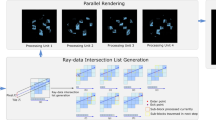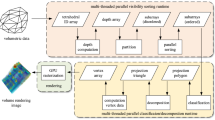Abstract
A parallel preintegration volume rendering algorithm based on adaptive sampling is proposed in this paper to visualize large-scale scientific data effectively on distributed-memory parallel computers. The algorithm sets sampling points adaptively by detecting the extremal points of a data field along the rays, so it can grasp the data variation exactly. After the data field is sampled distributedly on CPU cores, the resulting sampling points are sorted by piecewise packing orderly sampling points and then composited along each ray using the preintegration technique. In the algorithm, a static load balancing scheme based on information entropy is also proposed to balance the loads of both data reading and ray sampling. In addition, a mixed logarithmic quantization scheme is suggested to quantize depth distance so as to shorten the preintegration table while preserving the rendering quality. It is demonstrated that the presented algorithm can show inner features in a data field clearly and achieve a rendering speedup ratio between 1.8 and 4.4, compared with the traditional parallel volume rendering algorithm.
Graphical abstract










Similar content being viewed by others
References
Childs H, Brugger E, Bonnell K et al (2005) A contract based system for large data visualization. IEEE Visualization’05, pp 191–198
Childs H, Duchaineau M, Ma K (2006) A scalable, hybrid scheme for volume rendering massive data sets. EGPGV’06, Braga, Portugal
Cover T, Thomas J (2006) Elements of information theory (2nd Edition). Wiley-Interscience
Drebin R, Carpenter L, Hanrahan P (1988) Volume rendering. Comput Graph 22(4):65–74
Engel K, Kraus M, Ertl T (2001) High-quality pre-integrated volume rendering using hardware-accelerated pixel shading. Graph Hardware’01, pp 9–16
Frisken S, Perry R, Rockwood A, Jones T (2000) Adaptively sampled distance fields: a general representation of shape for computer graphics. In: Proc SIGGRAPH’00, pp 249–254
Guetat A, Ancel A, Marchesin S, Dischler J (2010) Pre-integrated volume rendering with non-linear gradient interpolation. IEEE Trans Vis Comput Graph 16(6):1487–1494
Hajjar J, Marchesin S, Dischler J, Mongenet C (2008) Second order pre-integrated volume rendering. PacificVis’08, pp 9–16
Kähler R (2005) Accelerated volume rendering on structured adaptive meshes. PhD thesis, Freien Universität Berlin
Kaufman A, Mueller K (2005) Overview of volume rendering. Chapter for The Visualization Handbook. In: Johnson C, Hansen C (eds), Academic Press
Kraus M, Qiao W, Ebert D S (2004) Projecting tetrahedra without rendering artifacts. Proceedings of IEEE Visualization, pp 27–34
Kraus M, Strengert M, Klein T, Ertl T (2007) Adaptive sampling in three dimensions for volume rendering on GPUs. The 6th international Asia-Pacific symposium on visualization, pp 113–120
Levoy M (1988) Display of surfaces from volume data. IEEE Comput Graph Appl 8(3):29–37
Levoy M (1990) Efficient ray tracing of volume data. ACM Trans Graph 9(3):245–261
Li X, Chen W, Tao Y et al (2014) Efficient quadratic reconstruction and visualization of tetrahedral volume datasets. J Vis 17(3):167–179
Lum E, Wilson B, Ma K (2004) High-quality lighting and efficient pre-integration for volume rendering. Proc of joint eurographics-IEEE TVCG symposium on visualization, pp 25–34
Ma K (1999) Parallel rendering of 3D AMR data on the SGI/Cray T3E. The 7th symposium on the frontiers of massively parallel computation, pp 138–145
Ma K, Painter J, Hansen C, Krogh M (1994) Parallel volume rendering using binary-swap compositing. IEEE Comput Graph Appl 14(4):59–68
Marchesin S, de Verdière G (2009). High-quality, semi-analytical volume rendering for AMR data. IEEE Visualization’09
Molnar S, Cox M, Ellsworth D, Fuchs H (1994) A sorting classification of parallel rendering. IEEE Comput Graph Appl 14(4):23–32
Moloney B, Weiskopf D, Möller T, Strengert M (2007) Scalable sort-first parallel direct volume rendering with dynamic load balancing. EGPGV’07
Tang W, Yao L, Yang J, Qin H (2008) An adaptive sampling algorithm based on vector field for medical volume rendering. J Shanghai Jiaotong Univ, 42(10) (in Chinese)
Wang C, Yu H, Ma K (2008) Importance-driven time-varying data visualization. IEEE Trans Visual Comput Graph 14(6):1547–1554
Wu G, Chen H, Cao Y (2012) Information theory in visualization analysis of multivariate time-varying scientific data. Proceedings of IADIS CGVCVIP ‘2012, Lisbon, Portugal, pp 75–82
Acknowledgments
The authors wish to thank the anonymous reviewers for their valuable comments. This work is supported by Science and Technology Funds of Chinese Academy of Engineering Physics under grant No. 2015B0403093, Key Program of Science and Technology Funds of Chinese Academy of Engineering Physics under grant No. 2014A0403019, Foundation of Laboratory of Computational Physics and National Natural Science Foundation of China (No. 61232012).
Author information
Authors and Affiliations
Corresponding author
Rights and permissions
About this article
Cite this article
Wang, H., Ai, Z., Cao, Y. et al. A parallel preintegration volume rendering algorithm based on adaptive sampling. J Vis 19, 437–446 (2016). https://doi.org/10.1007/s12650-015-0339-1
Received:
Revised:
Accepted:
Published:
Issue Date:
DOI: https://doi.org/10.1007/s12650-015-0339-1




